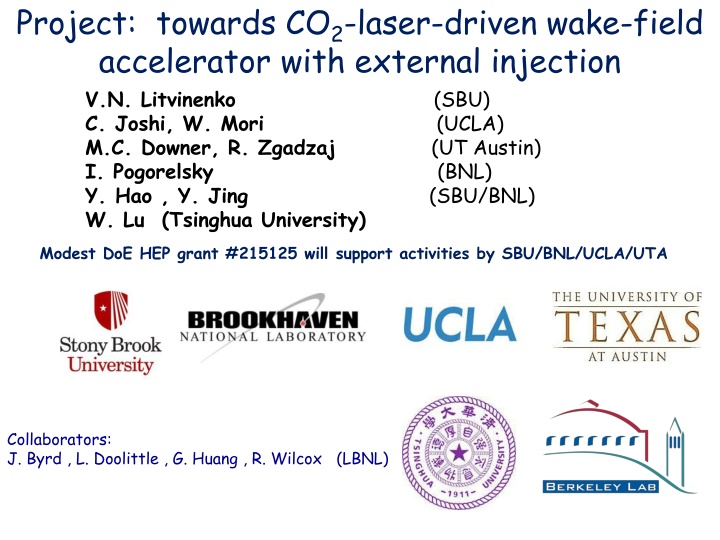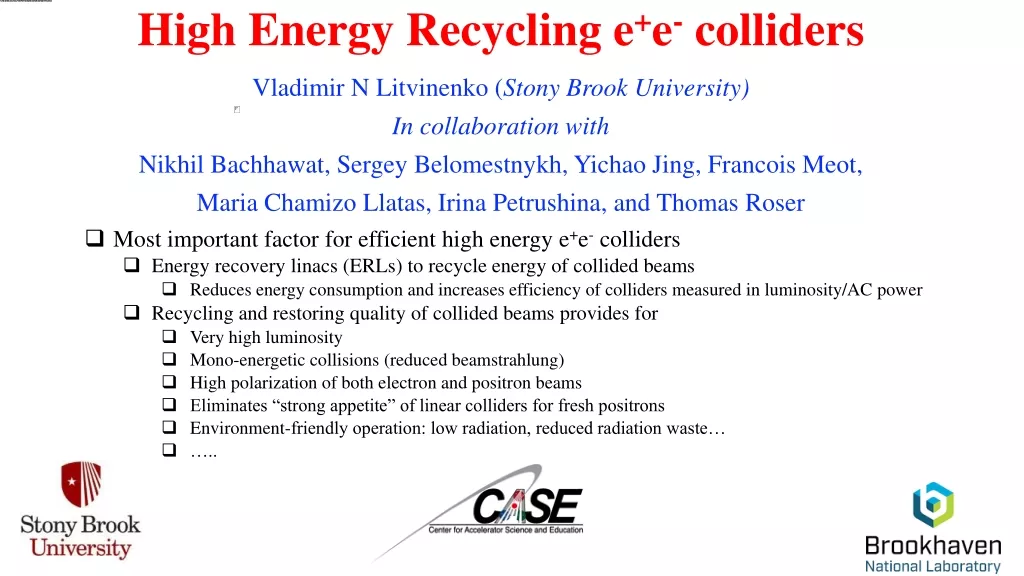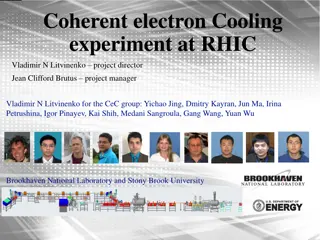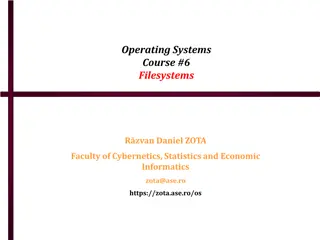
CO2-Laser-Driven Wake-Field Accelerator Project
"Explore advancements in CO2-laser-driven wake-field accelerator technology with external injection for high-quality electron beam acceleration, featuring key components development and laser system upgrades."
Download Presentation

Please find below an Image/Link to download the presentation.
The content on the website is provided AS IS for your information and personal use only. It may not be sold, licensed, or shared on other websites without obtaining consent from the author. If you encounter any issues during the download, it is possible that the publisher has removed the file from their server.
You are allowed to download the files provided on this website for personal or commercial use, subject to the condition that they are used lawfully. All files are the property of their respective owners.
The content on the website is provided AS IS for your information and personal use only. It may not be sold, licensed, or shared on other websites without obtaining consent from the author.
E N D
Presentation Transcript
Project: towards CO2-laser-driven wake-field accelerator with external injection V.N. Litvinenko C. Joshi, W. Mori (UCLA) M.C. Downer, R. Zgadzaj (UT Austin) I. Pogorelsky (BNL) Y. Hao , Y. Jing W. Lu (Tsinghua University) (SBU) (SBU/BNL) Modest DoE HEP grant #215125 will support activities by SBU/BNL/UCLA/UTA Collaborators: J. Byrd , L. Doolittle , G. Huang , R. Wilcox (LBNL)
Basics We would like to explore large (e.g. psec or 0.5 mm) length of bubble in CO2-laser driven plasma wake-field accelerator Matching injecting of an external high quality electron bunch with duration ~ 10 fsec and synchronizing it with the bubble should allow us to accelerate high quality electron beams with energy stability an spread reaching towards 10-4 CO2-laser power upgrades are in progress at BNL, independently from this project Use visible diagnostics (since plasma is designed for CO2-laser) Our project is devoted towards developing key components necessary for such experiment: Plasma source with ramp-up and ramp-down density profiles Electron bunch compressor to 10 fsec with emittance preservation Visible laser diagnostics for the plasma
2 TW BNL CO2 laser system LPAW 2015 SOLID-STATE OPA INJECTOR REGENERATIVE ISOTOPIC AMPLIFIER MAIN AMPLIFIER 400 fs 40 J 2 ps 10 mJ 3 ps 6 J I. Pogorelsky 3 3
New concept of 100TW CO2 laser LPAW 2015 Collection of innovations: 35 J 350 fs Amplifier 1 OPA: fs seed 10 J 100 ps Stretcher + compressor = Chirped pulse amplification Ti:Al2O3 OPA Stretcher 100 mJ High-pressure, isotopic amplifiers Amplifier 2c Amplifier 2b Amplifier 2a Nonlinear compressor 70 J Non-linear compressor (patent) 50 J 2 ps 25 TW 10 J 100 fs 100 TW Vacuum grating compressor I. Pogorelsky 4
Looking towards ATF II with the 100TW CO2 upgrade CO2 laser will drive bubble-regime wakes Experiments will be conducted in 10 to 100 cm long plasma source with density 5 x 1015 < ne < 1017 cm-3 that will be built by C. Joshi team. Two parameter sets for LWFA at ATF II. (C. Joshi) Laser Intensity Dephasing Energy Gain Spot a0 (W/cm2) Length (cm) MeV w0( m) wm( m) 2 4x1016 10 666 200 150 12.6 4 1.6x1017 14 1332 100 212 3.1 Matched-spot Rayleigh Length (mm) Comprehensive study of external injection of ~ 10fs x ~ 3 m bunches from the ATF linear accelerator into the plasma accelerator, operated below its self-injection threshold. Work will be supported by full simulations of all key processes in the proposed LFWA. (W. Mori)
Example of the CO2-laser driven bubble Simulated bubble in plasma density 1.1 x 1016 cm-3 ,driven by 500 fsec CO2 laser with a0 =1.4 Wei Lu The bubble , or ion cavity, will have typical lateral dimension ~ 300+ m, time duration ~1+ psec for ne = 1016 cm-3. Its large size will allow unprecedented detail in the visualization of the bubble structure, its shot to shot variations, and evolution.
Self-modulated wakes with current ATF I CO2 laser parameters Normalized laser field Normalized plasma density 2.5TW, 2ps pulse, after 6.7cm of propagation in 1x1016 cm-3 plasma. The laser pulse self modulates, its peak intensity grows by more than 50%, and a strong wake is produced, with wake amplitude greater than 1GV/m. N.Andreev
ATF II ZigZag compressor Taking care of CSR Energy, MeV Bunch length, fsec 150 10 Y. Jing
Bunch Compression: existing ATF beam New Zig-Zag type compressor will be installed in ATF to compress bunches to 12fs Energy, MeV 70 Bunch length, mm 0.06 Chirp, m-1 20 Bunch length, rms, fsec 12 Y. Jing
Conventional Accelerator Plasma Accelerator Copper Structure with irises Powered by microwaves Energy Gain 20 MV/m Structure Diameter 10cm Ionized Gas Lifetime, few picoseconds Powered by a Laser or electron beam pulse Energy Gain 20 GV/m Diameter 0.1-I mm Big advantage: our plasma is transparent for visible lasers .3 mm 1 m M.C. Downer, R. Zgadzaj, UT Austin
Our current plans Develop plasma source for the experiment Simulate the processes including injection into the plasma Develop initial plasma diagnostics Design and test bunch compressor suitable for external injection Start tests with existing CO2 laser and electron beam When CO2 laser operates at necessary peak power attempt to inject the beam into the plasma accelerator Our project is approved as ATF experiment AE71 We acknowledge support from US DoE HEP office - grant #215125
Frequency domain streak camera (FDSC) Z. Li, et al., Frequency-domain streak camera for ultrafast imaging of evolving, light-speed objects, Opt. Lett. 35, 4087-4089 (2010) - 0.5 0.2 - 1.0 rad mm 0 - 1.5 - 2.0 -0.2 -0.5 0 0.5 ps
Synchronization is currently is not in the scope Scheme developed in LBNL to achieve laser and e-bunch synchronization to 10-20fs. Currently we do not have funds to pursue its implementation it would be future step. TX : Transmitter; RX: Receiver Single e-bunch detection: high freq. cavity or electro-optical modulator Single CO2 pulse detection: Develop optical ring-down cavity J. Byrd , L. Doolittle , G. Huang , R. Wilcox (LBNL)




